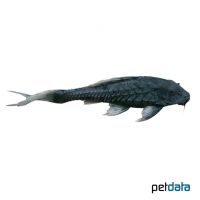Pinecone Pleco (Pseudorinelepis genibarbis)
| Pinecone Pleco Pseudorinelepis genibarbis | |
|---|---|
| Name | Pinecone Pleco |
| Name Lat. | Pseudorinelepis genibarbis |
| Family | Suckermouth Armoured Catfishes |
| Family lat. | Loricariidae |
| Order | Catfishes |
| Order lat. | Siluriformes |
| Origin | Peru, Brazil |
| Habitat | Rivers, streams |
| Diet | Omnivore, soft wood |
| pH | 5.5-7.5 |
| Behavior | Nocturnal, peaceful |
| Keeping | Individual, group |
| Care Level | Difficult |
| Reproduction | Substrate spawner |
| Breeding | None reported |
| Life Span | 8-10 years |
| Protection | No |
| Metric Units | |
| Size | 35-40 cm |
| Temperature | 23-27 °C |
| Hardness | 2-20 °dH |
| Aquarium | ~ 500 l |
| US Units | |
| Size | 14"-16" |
| Temperature | 73-81 °F |
| Hardness | 36-356 ppm |
| Aquarium | ~ 130 gal |
Distribution and habitat
Red-bearded pine cone catfish are common in the upper Amazon River basin of Peru and Brazil. There are some local color variations. They live in slow-flowing jungle streams and rivers, preferably among dead wood and roots that protrude into the water.
Maintenance
The aquarium should have a robust border planting with stones, caves (catfish burrows) and roots, which provide hiding places and at the same time are part of the food. A substrate of sand and round-grained gravel, subdued light (floating plant cover) and a weak current is ideal.
No ammonia, ammonium and nitrite should be detectable, the nitrate value should not exceed 100 mg/l. To ensure the water quality and oxygen content, a filter and heater adapted to the aquarium size is required, as well as lighting for the species-appropriate day-night rhythm of the animals.
Diet
They feed on plant and animal food. For a balanced diet, feed once a day with a high-quality dry food for loricariid catfish (granules, pellets, chips, tablets), supplemented with algae leaves, soft wood and fresh vegetables, such as zucchini, broccoli, bruised peas, scalded spinach, as well as zoopankton, cyclops, daphnia, artemia, mosquito larvae, shrimp, etc. (live or frozen)
Feed only as much as will be eaten within a few minutes, excluding plant foods. Regular and varied feeding promotes health and increases resistance.
Behaviour and compatibility
They are crepuscular to nocturnal. Within the species they behave occasionally territorial, so several animals should be maintained only in a richly structured tank. They are very peaceful towards other fish and are well suited for a community tank
Basically, only compatible fish species with similar demands on water quality and water temperature may be socialized.
Sex dimorphism
There are no known external distinguishing characteristics.
Reproduction and breeding
There are no known reports of successful breeding in the aquarium.
Important
They have a strong sucking mouth, with spoon-shaped teeth for scraping wood, and intestinal flora that allows the fish to digest the cellulose.
When fishing, use the finest mesh nets possible to prevent the hard rays of the pectoral fins or the skin teeth (odontodes) from getting caught on the bone plates, which can cause painful puncture wounds when touched.
The well-being of the fish should be checked regularly. Temperature should be checked daily, pH, hardness and nitrate levels at least every 14 days. Regular partial water changes are recommended, even when contaminant levels have not yet reached the upper limit. Sudden changes in water quality should be avoided. Newly introduced fish must be accustomed slowly to the water in the aquarium.
Further literature can be found in your pet store.
References
Text: Werner Winter; Image: petdata
Source: BMEL (1998): Tierschutzgutachten - Haltung von Zierfischen (Süßwasser); BAENSCH & RIEHL (1997): Aquarien Atlas Bd. 5, Mergus Verlag; SCHMIDT, WERNER, LECHNER (2005): MiniAtlas L-Welse, Bede Verlag ENGELMANN (2005): Zootierhaltung - Tiere in menschlicher Obhut: Fische, Verlag Harri Deutsch
- Gemäß § 21 Abs. 5 Tierschutzgesetz idgF
